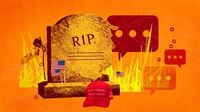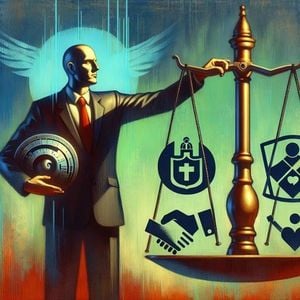Over the Labor Day weekend of 2025, a peculiar and persistent rumor swept across social media: President Donald Trump was dead. In a digital echo chamber fueled by speculation, memes, and political rivalry, the hashtag #trumpisdead trended on X, Reddit, YouTube, and Bluesky, leaving millions of Americans—and even some in the president’s own family—wondering what was really going on behind the closed doors of the White House.
According to The Poynter Report, the origins of the hoax can be traced to a confluence of three factors: Trump’s brief absence from the public eye, a mischaracterized quote from Vice President J.D. Vance, and the president’s well-documented but non-life-threatening health condition. On August 28, 2025, USA Today published an interview with Vance in which he was asked if he was ready to assume the presidency should the need arise, given Trump’s age—at 79, the oldest president ever sworn in. Vance replied that he was prepared but emphasized Trump’s good health. Nevertheless, social media users seized on the first part of his answer, spinning it into a narrative that the president was either gravely ill or already dead.
Trump’s schedule, which had slowed after an August 26 cabinet meeting, became another source of speculation. As a president known for his frequent public appearances and combative news conferences, his absence for just a few days was enough to set the rumor mill spinning. By early September, posts containing the phrase “Trump is dead” had appeared more than 5,600 times across major platforms, with the most engagement on X, according to Rolli IQ, a social media monitoring service cited by Poynter.
Adding fuel to the fire were viral images of Trump’s bruised right hand and swollen ankles. As reported by Al Jazeera and The Week, these photos circulated widely, with some users theorizing that the president had been on an IV drip or was suffering from a serious ailment. In reality, Trump’s physician explained that the bruising was simply irritation from frequent handshaking and the use of aspirin as a standard cardiovascular preventative measure. White House press secretary Karoline Leavitt had already revealed in July that Trump was dealing with chronic venous insufficiency—a benign and common condition in elderly people that causes mild swelling in the lower legs.
But the internet has never been known for its patience with medical nuance. Instead, the lack of public appearances, the ambiguous comments from Vance, and the photographic evidence of physical wear combined into a perfect storm of misinformation. As Poynter noted, liberal social media influencers on TikTok and other platforms made videos that collectively racked up millions of views, questioning Trump’s health and demanding transparency from the White House. Some acknowledged that Trump was alive, sharing photos of him leaving the White House to go golfing, while others scrutinized the images, insisting he looked sick or weak.
The rumor gained further momentum when Trump himself attempted to quell speculation by posting a photo on Truth Social of himself golfing with former NFL coach Jon Gruden. Eagle-eyed critics quickly pointed out that Gruden was wearing the same outfit he had worn at the same golf course a week earlier, sparking accusations that the photo was old and therefore not credible proof of life. According to Daily Mail, Trump was actually seen golfing with his granddaughter Kai on September 1, 2025—a fact confirmed by his son, Donald Trump Jr., who told Newsmax, “I called my father over the weekend and be like, ‘Hey, just want to make sure you’re not dead. I know my daughter’s playing golf with you as we speak, you know, I keep reading about it on Twitter, so I just want to make sure.’ [He] didn’t even know what I was talking about.”
Meanwhile, the rumor was not confined to right-wing circles or conspiracy theorists. According to Will Cain Country and commentary from Megyn Kelly and Batya Ungar-Sargon on NewsNation, prominent figures on the left, including Jen Psaki and Minnesota Governor Tim Walz, latched onto the rumors, sometimes reveling in what appeared to be wishful thinking. The reaction from left-leaning media and activists was described as “sick” by Ungar-Sargon, who discussed the glee some expressed at the possibility of Trump’s demise.
As the story reached a fever pitch, even Trump’s family was drawn into the drama. Donald Trump Jr.’s call to his father was both a personal check-in and a public statement, intended to reassure supporters and detractors alike that the president was alive and well. Trump himself finally put the rumors to rest with a live press conference from the White House on September 2, 2025. Fox News Senior White House Correspondent Peter Doocy asked about the speculation, to which Trump replied, “I didn’t see that. I have heard. It’s sort of crazy, but last week I did numerous news conferences. All successful, they went very well. Like this is going very well. And then I didn’t do any for two days and they said ‘There must be something wrong with him.’” Trump went on to criticize the media for what he described as a double standard, noting, “I didn’t do any [public events] for two days, and they said there must be something wrong with him. Biden would not do them for months, you wouldn’t see him, and nobody ever said there was ever anything wrong with him, and we know he wasn’t in the greatest of shape.”
Commentators across the spectrum noted that rumors about the health and even the death of political leaders are nothing new. According to The Week, such tales have plagued figures from Joseph Stalin to Fidel Castro, and even President Joe Biden has been the subject of similar hoaxes. The difference now, experts told Poynter, is the speed and reach of social media. “For rumors to spread, they must ‘have some degree of plausibility,’” Psychology Today observed, with advanced age and a history of health concerns lending credibility to the speculation. Social media, notorious for amplifying unverified claims, allows such rumors to spread quickly and widely, creating what’s known as the “illusion of truth.”
In the end, the Trump death hoax of 2025 fizzled as quickly as it had flared, with the president’s live appearance and pointed humor putting the story to rest. Yet the episode served as a powerful reminder of the volatility of the modern information ecosystem—and the ease with which misinformation can take root, especially in a polarized political climate.
For now, President Trump remains very much alive, both on the golf course and in the public arena, undeterred by the rumors that briefly threatened to write his political obituary.




